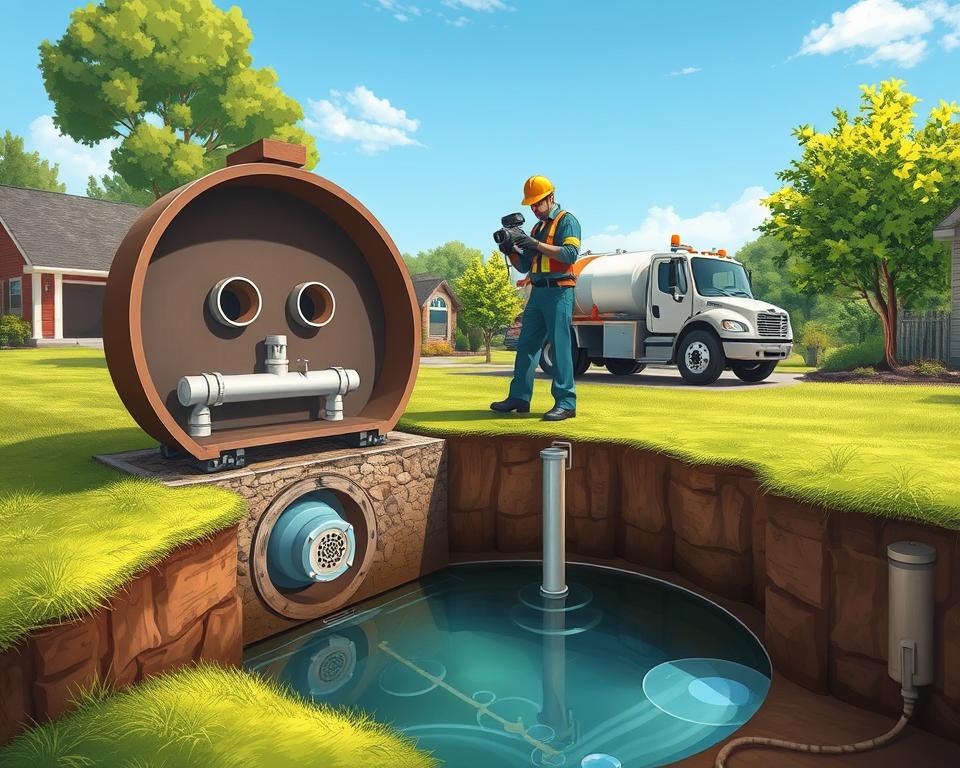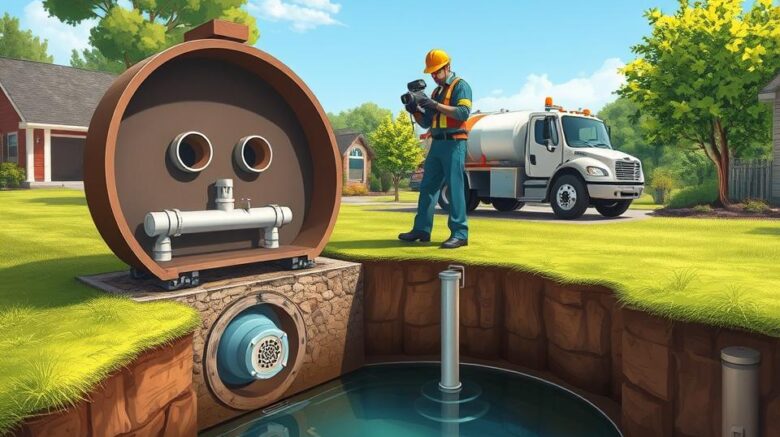Aerobic Tank Air Pump: Must-Read Guide for Householders
Curious about what boosts your aerobic Septic setup’s efficiency? The Septic air pump is the unsung hero crucial for your system. In this article, homeowners will gain essential information on the air Pump’s purpose. It’s critical for a healthy, well-run Septic tank.
Understanding the necessity of a Septic tank air Pump can enhance your Septic system’s operation using septic air pump. It also secures your property’s value and surrounding ecosystem. The resource below will introduce All in Sanitation, a reputable Septic industry expert. They’re ready to meet your Septic aerator Pump demands.
Vital Takeaways
- The Septic air Pump is paramount for oxygen-based Septic setups.
- Maintaining your Septic system air Pump can boost overall system performance.
- Routine inspections increase the service life of your Septic tank air Pump.
- Selecting the proper Septic aerator Pump is essential for maximum operation.
- All in Sanitation delivers tailored services for Septic air Pump support.
Breaking Down Aerobic Septic Units
Aerobic Septic systems offer a enhanced waste treatment alternative by employing oxygen. This technique relies on aerobic bacteria flourishing in well-oxygenated environments. These bacteria are faster in processing organic matter. With the help of Septic aerator Pumps, these systems deliver a constant oxygen supply, boosting the waste decomposition process.
These systems excel in reducing sludge buildup, owing to the hard work of aerobic bacteria. This drop in solid waste means reduced upkeep and Pumping is required less often. Additionally, they reliably process wastewater, producing barely any odor. This produces a healthier environment for homeowners and the community as a whole.
To guarantee these systems work smoothly, it’s essential to grasp the key Septic system components. These include the Septic tank, aeration chamber, and effluent Pump. Each part has a crucial role, especially the air Pump. It pushes oxygen into the tank, essential for the aerobic bacteria’s efficiency.
Role of the Septic Air Pump
The Septic air Pump is central in the performance of aerobic Septic systems. It serves as the system’s “breathing mechanism,” pushing the necessary oxygen needed. This oxygen enables aerobic bacteria to flourish and break down waste efficiently. If the Pump stops, the system’s performance drops, resulting in sludge buildup and possible odors.
Such issues can undermine Septic system operations and create environmental hazards. By realizing how critical the Septic air Pump is, homeowners can act preemptively. They can maintain its peak function through regular maintenance. This avoids failures, reduces costly repairs, and maintains the aerobic system’s integrity.
Top Advantages of Using a Septic Air Pump
Utilizing a Septic air Pump notably enhances the effectiveness of Septic systems. Septic air Pumps are essential as they quicken the processing of waste. This is done by oxygenating the treatment process, encouraging aerobic bacteria growth. These bacteria are necessary for efficient waste treatment.
They’re also important in reducing foul smells. Due to more active aerobic processes, waste is treated faster, thus diminishing odors. This ensures better surroundings for homeowners.
Another valuable benefit is the decrease in sludge accumulation. Consequently, tanks demand less frequent Pumping, conserving both money and time. Greater processing not only cuts expenses but also extends the lifespan of the drain field.
Looking after these Pumps diligently means minimal repair costs and satisfying regulatory standards. Thus, the upsides of Septic air Pumps aren’t just for homeowners. They also benefit environmental health by optimizing waste management practices.
| Benefit | Description |
|---|---|
| Fast Waste Breakdown | Heightened aerobic activity accelerates the decomposition process. |
| Minimized Odor Emissions | Better treatment efficacy leads to fewer odors. |
| Reduced Sludge Buildup | Less frequent Pumping and maintenance are necessary. |
| Extended Drain Field Life | Better treatment equals a healthier drain field. |
| Cost Savings | Lower chance of repairs and regulatory compliance cost. |

Picking an Ideal Septic Air Pump
Picking the right Septic air Pump is vital for an optimized aerobic system. Homeowners ought to review various factors for the ideal match. The capacity of the tank and the airflow needs significantly influence the Pump’s performance.
To select well, it’s useful to know the air Pumps available. There are mainly two types: linear diaphragm Pumps and rotary vane Pumps. Each comes with particular pluses, which should be matched with your home’s unique requirements and daily load.
Electric efficiency also should be considered. Choosing a Pump that lowers energy use while supplying the needed airflow can offer meaningful reductions. Assistance from All in Sanitation professionals can be very helpful. They make certain the Pump you choose fits your system’s requirements precisely.
Common Types of Septic Air Pumps
Homeowners can select wisely by knowing the various Septic air Pumps available. There are mainly two types: diaphragm Pumps and rotary vane Pumps. Each has its specific functions and benefits.
Diaphragm Pumps, known for their low-noise operation, are favored for residential Septic systems. They deliver energy efficiency while ensuring stable air output. Their constant performance fits smaller systems, meeting the needs of many homeowners.
Rotary vane Pumps, however, are designed for larger or commercial systems. These Pumps produce increased power, required when handling bigger loads. Their robust build guarantees efficient operation in extensive Septic systems.
| Type of Pump | Best Use | Advantages |
|---|---|---|
| Diaphragm Pumps | Residential Systems | Quiet operation, energy-efficient, reliable air flow |
| Rotary Vane Pumps | Larger or Commercial Systems | Powerful performance, high capacity, durable construction |
Recognizing the differences in Septic air Pumps is vital for upgrades or replacements. Each Pump type delivers distinct traits to address various needs. This guarantees peak performance for any system.
Clues Pointing to a Septic Air Pump Replacement
Homeowners must be alert to Pump failure signs in their Septic systems. Some indicators show the need for a Septic air Pump replacement. These ensure continued performance. Spotting these early stops major issues.
Signs of potential problems include:
- Unusual noises from the Pump, like grinding or trembling, might suggest internal damage.
- A clear lack of air output reveals the Pump isn’t performing as intended, reducing efficiency.
- Regular electrical problems, such as tripped breakers or voltage drops, could show overloading.
- Visible damage on the Pump unit, with fractures or leaks, needs quick action.
- Offensive smells in the yard often indicate a compromised Pump, meaning ineffective effluent aeration.
Spotting these signs early avoids costly fixes or total system failure. Conducting regular checks makes it easy to catch these issues. It also shows if you require a new Septic air Pump.
Care Guidelines for Your Septic Air Pump
For an effective Septic air Pump, consistent service is vital. This guarantees that your system functions properly. Homeowners can apply several straightforward care strategies for peak results.
Twice a year, conduct a detailed inspection for wear or damage. It is also crucial to change the filters as recommended. This reduces clogs that could reduce efficiency.
The Pump should rest on a stable base to lessen vibrations, which could wear it over time. A protective cover is vital too. It guards against debris and water, keeping the Pump’s functionality.
Proper maintenance can considerably extend the life of your Pump. In turn, this benefits the Septic system’s performance as a whole.
| Maintenance Task | Frequency | Benefits |
|---|---|---|
| Inspect Pump for damage | Every 6 months | Catches problems quickly |
| Replace filters | As needed | Improves efficiency |
| Check surface stability | Annually | Reduces vibrations |
| Clear debris around Pump | Monthly | Maintains airflow |
Setting Up Your Septic Air Pump
Correct installation of your Septic air Pump is critical for its efficient operation. Initially, pick a safe, moisture-free area for placement. The chosen spot should securely support the Pump’s weight without strain.
To properly set up your Pump on your own, use the following guidelines:
- Gather all necessary items, including the Pump, a power source, and hose fittings.
- Thoroughly review the manufacturer’s guidelines before beginning your installation.
- Confirm every connection is tight to avoid air leaks that compromise performance.
- After assembly, conduct a test to verify the system works as intended.
If the installation process looks challenging, call All in Sanitation. Their professionals can avoid common errors, ensuring your setup follows strict safety requirements.
Advantages of Using All in Sanitation for Your Septic Air Pump Requirements
When choosing a Septic service provider, the choice is key. All in Sanitation sets itself by supplying dependable Septic air Pumps. They serve wide-ranging homeowner requirements with a extensive selection of quality products. This guarantees customers discover an ideal match for their Septic systems.
What truly separates All in Sanitation is more than their diverse product lineup. Their commitment to outstanding customer service is just as important. Homeowners benefit from specialist insight, helping them choose trusted Septic solutions. This partnership is crucial to customize each solution to fulfil specific needs.
All in Sanitation also focuses on aftercare to guarantee lasting satisfaction. Their dedication goes beyond the initial sale. They provide ongoing support to ensure Septic systems operating efficiently for the long haul.
Cost Considerations for Septic Air Pumps
Grasping the costs linked to Septic air Pumps is vital for homeowners operating aerobic Septic systems. Up front, one faces the initial cost, which includes the Pump and required accessories. Installation expenses fluctuate, in line with the system’s complexity and any alterations required.
Ongoing upkeep forms an additional cost layer. Consistent assessments can head off bigger issues, eventually resulting in savings. Homeowners should plan for Septic maintenance to retain the Pump’s effectiveness and service life. Such planning sidesteps expensive repairs later on, highlighting the value of proactive maintenance.
| Cost Component | Average Cost Range |
|---|---|
| Septic Air Pump | $500 – $1,200 |
| Installation | $300 – $800 |
| Annual Maintenance | $150 – $400 |
| Potential Repair Costs | $1,000 – $5,000 |
Itemizing Septic air Pump expenses into distinct parts assists homeowners in financial preparation. This careful approach ensures the system’s consistent operation and their peace of mind.
To Conclude
For homeowners with aerobic Septic systems, looking after Septic tanks is key. The appropriate Septic air Pump improves waste processing and lengthens your system’s life. Sticking with regular upkeep and promptly addressing issues stops expensive repairs and disruptions.
Opting for a Septic air Pump warrants consideration. This guide highlighted how to select effectively about installation and replacement. With All in Sanitation’s help, you can handle your Septic systems’ complexities confidently.
Taking care of your Septic air Pump enhances your system’s functionality and life span. It provides a efficient and successful operation over time. Bear in mind, your home’s wastewater management is strongly influenced by ongoing maintenance.
